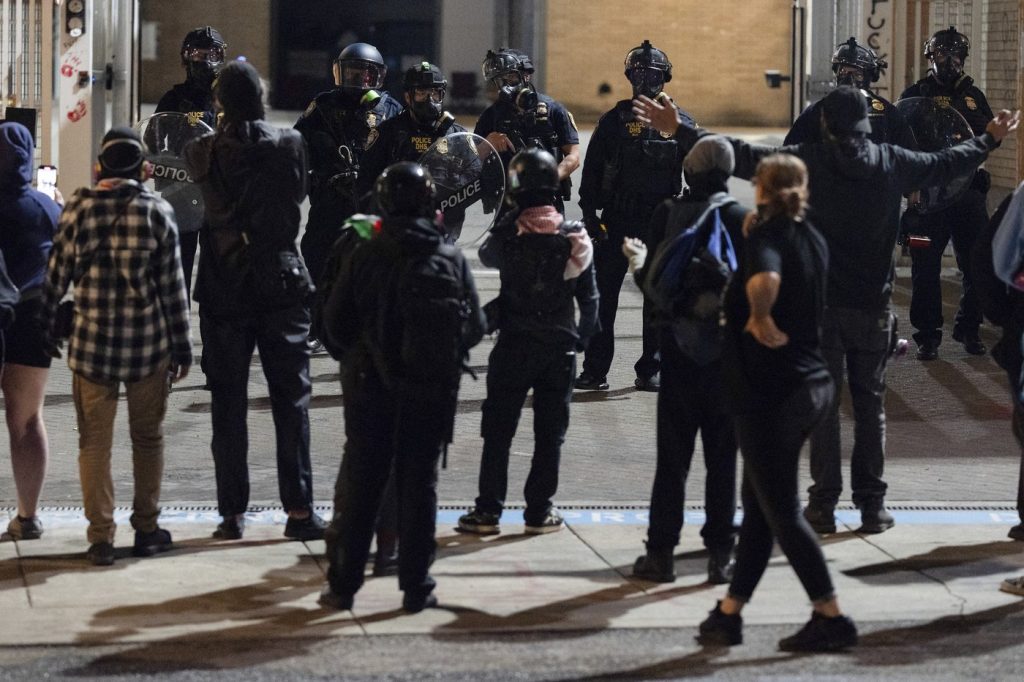PORTLAND, Ore. – A gas mask hung from Deidra Watts's backpack as she joined a gathering of a few dozen protesters outside the U.S. Immigration and Customs Enforcement (ICE) building in Portland. This has become a regular occurrence for her since July. The protesters stood along a blue line painted across the building's driveway that read, “GOVERNMENT PROPERTY DO NOT BLOCK.” Whenever they lingered too close, officers posted on the roof responded by firing what appeared to be pepper balls at them. Fortunately, no injuries were reported during the events that unfolded on a Wednesday night, and many participants began to disperse by midnight.
Despite causing disruptions for nearby residents, particularly prompting a charter school to relocate this summer, the nightly demonstrations have been significantly calmer compared to the civil unrest that engulfed Portland following the murder of George Floyd by Minneapolis police in 2020. However, these protests have still garnered considerable attention, including from President Donald Trump, who previously engaged in heated exchanges with Portland's mayor during the 2020 riots.
In a recent statement, Trump characterized living in Portland as “like living in hell” and indicated he might consider sending in federal troops to deal with the unrest, drawing parallels to his law enforcement actions in other U.S. cities like Chicago and Baltimore. Although Trump is noted for deploying the National Guard to Los Angeles over the summer, crime rates have actually seen a decline across the nation, including in Portland, where a report indicated a 51% decrease in homicides from January through June compared to the same period in 2024.
Casey Leger, a 61-year-old observer at the protests, described the situation as a “propaganda campaign” aiming to present Portland as a chaotic environment. He noted that just two blocks away, one could find solace by the river while enjoying a soda and watching birds. The ICE building is located along a busy road connecting Portland to its suburbs, next to affordable housing complexes. During daylight hours, advocates like Leger hand out “know your rights” flyers that feature a hotline number for reporting ICE arrests, while at night, Watts and other protesters, often dressed in black and equipped with helmets or masks, stage their demonstrations. Watts labeled ICE a “callous and cruel machine,” asserting that public dissent is necessary to signal disapproval of their actions.
The protests intensified in June after the nationwide “No Kings” marches, culminating in police declaring one such event a riot. Since then, 26 protesters have been charged with federal offenses related to the ICE building, including assaults on federal officers, according to the U.S. Attorney's Office in Oregon. In response to Trump’s threats of federal intervention, Portland Mayor Keith Wilson stated he had not requested and did not require federal assistance, emphasizing the city’s commitment to safeguarding freedom of expression while managing occasional violence and property damage.
Smaller confrontations have continued since June, including a notable incident on Labor Day when some demonstrators displayed a prop guillotine, which the Department of Homeland Security condemned as “unhinged behavior.” Mayor Wilson anticipates that protests will remain focused around the ICE building. However, this ongoing noise and unrest have frustrated residents of the nearby apartments, with at least one individual filing a lawsuit in an attempt to compel the city to enforce noise ordinances. This resident claimed that sounds from bullhorns and other protest-related noises had caused her eardrum to burst, and gas infiltration into her apartment resulted in illness, but a judge ruled in favor of the city.
Rick Stype, a ten-year resident of the area, expressed his discontent, stating that he joined neighbors outside in order to avoid harassment from protesters. “I just want them to leave us alone,” he remarked. Additionally, the Cottonwood School of Civics and Science, a charter school adjacent to the ICE building, chose to relocate over concerns regarding the safety of students due to crowd-control tactics and chemical agents used during protests. Chris Johnson, who owns a nearby coffee shop, lamented the school's departure and the exaggerated national narrative surrounding the protests, stating that it fosters division among community members.










